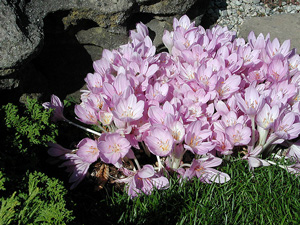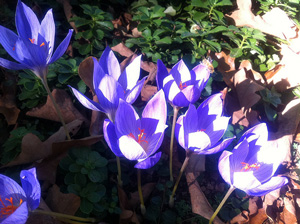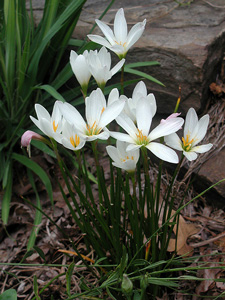Resource Library
Plant of the Week: Fall Bulbs
The University of Arkansas System Division of Agriculture does not promote, support or recommend plants featured in "Plant of the Week." Please consult your local Extension office for plants suitable for your region.
Plant of the Week
Fall bulbs
Latin: Crocus speciosa, Colchicum Byzantium, Zephranthes candida

Bulbs have always been a favorite of mine, and like most people, I associate them with spring. But a surprising number of species bloom in the fall and these always surprise and delight the observant gardener. Fall blooming bulbs have more competition for being noticed than their spring counterparts but they are no less beautiful.
The bulbous habit of growth has evolved in regions where the summers tend to be dry and the winters moist. Species have adapted to this condition by growing when moisture conditions are most suitable, either in the late winter and early spring or in the fall and early winter when rains return. The spring bloomers flower towards the end of their vegetative cycle while most of the fall bloomers flower at the beginning of their vegetative growth phase.
The beginning of the fall blooming season is somewhat arbitrary because species such as the pink flowered Lycoris squamigera, known as the naked ladies, produce their gaudy flamingo-like bloom stalks in early August from bulbs that made their vegetative growth six months earlier. Lycoris radiata (spider lily) produce their red, spidery blooms in early September and grow leaves that are evergreen through the winter, dying down with the first hot days of spring.
In late August to early September and very much depending on when the fall rains begin, the rain lilies start to flower. I grow several species and can report that so far only the white flowered Zephyranthes candida has put on a spectacular show in my zone 6/7 garden. It is a strong multiplier and with clumps divided every couple years a good showing can be had from this foot tall plant.
The golden-flowered Sternbergia lutea is another favorite in the fall garden because its funnel shaped flowers are two inches across and large enough to make a good display and the bright color is sure to attract attention. For me, it remains evergreen with the foliage dying down in mid spring.
The bulbs known in the trade as “autumn crocus” – the Colchicums – are not at all related to the crocus but instead are more closely allied with the lily family. I’ve started a small collection of the Colchicum species and their hybrids and after a decade in the ground can begin to make some observations on their performance. All that I have grown are in high shade in a well drained, humus rich soil. I have found them to be reliable bloomers and easy to grow but rather slow to multiply. Depending on the species and the rainfall patterns, they bloom from early September until early November.
Colchicum byzantinum is the first to flower for me and the most prolific in its rate of multiplication. Its lavender blooms are about 8 inches tall and has bloomed as early as August 28 and as late as September 25th. It has narrow, 16-inch long foliage that appears in late February and dies down by the first of May. C. autumnale and C. speciosum are also good bloomers for me but flower a bit later. Each colchicum bulb produces multiple blooms and by the end of its run of blooms looks a bit forlorn with some blossoms erect and showy while others lounge about in disarray.
The true fall blooming crocus make a good display and are worth growing if they can be located in open situations where their blooms can be seen. The showiest of the fall crocus is probably C. speciosa which blooms in mi October for me. It is ideal for naturalizing in lawns and will reseed if conditions are to its liking. Crocus sativus, the saffron crocus, blooms a bit later and has foliage that begins growing early and by spring sprawls about on the ground in a pile.

Other fall blooming bulbs are available but these few give an indication of the possibilities. Most should be planted in a well drained, bright if not sunny location where the foliage can be left alone to mature without being overshadowed by a neighboring plant. Other than that, all are easy to grow and will perform for years with little care.
For tips on planting fall bulbs:
Download Fall Bulbs Publication
By: Gerald Klingaman, retired
Retired Extension Horticulturist - Ornamentals
Extension News - September 28, 2012
The University of Arkansas System Division of Agriculture does not maintain lists of retail outlets where these plants can be purchased. Please check your local nursery or other retail outlets to ask about the availability of these plants for your growing area.
